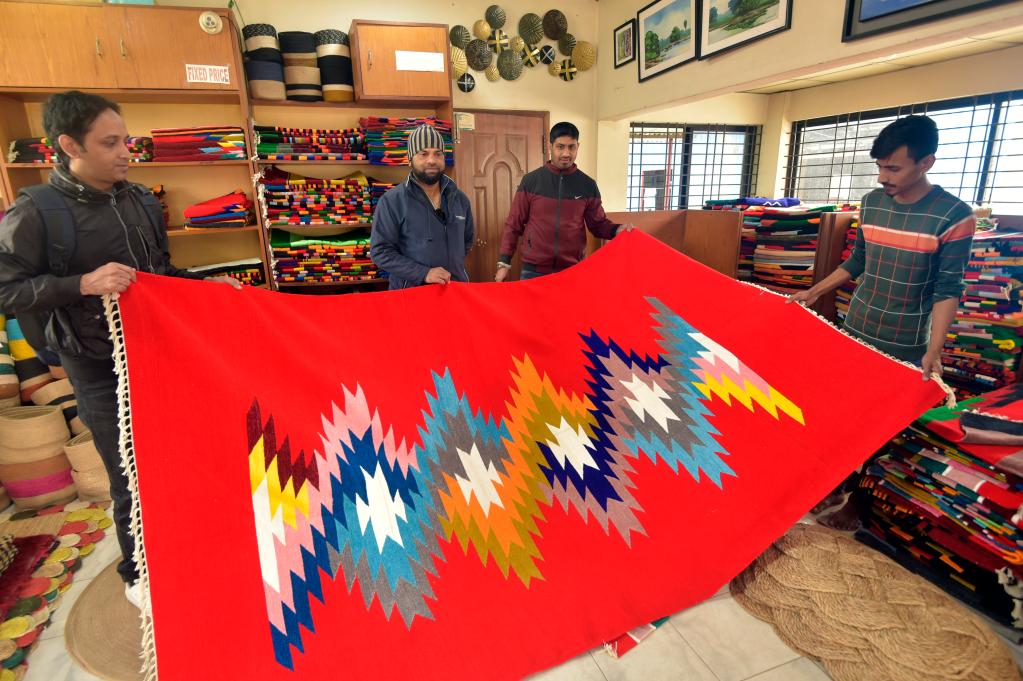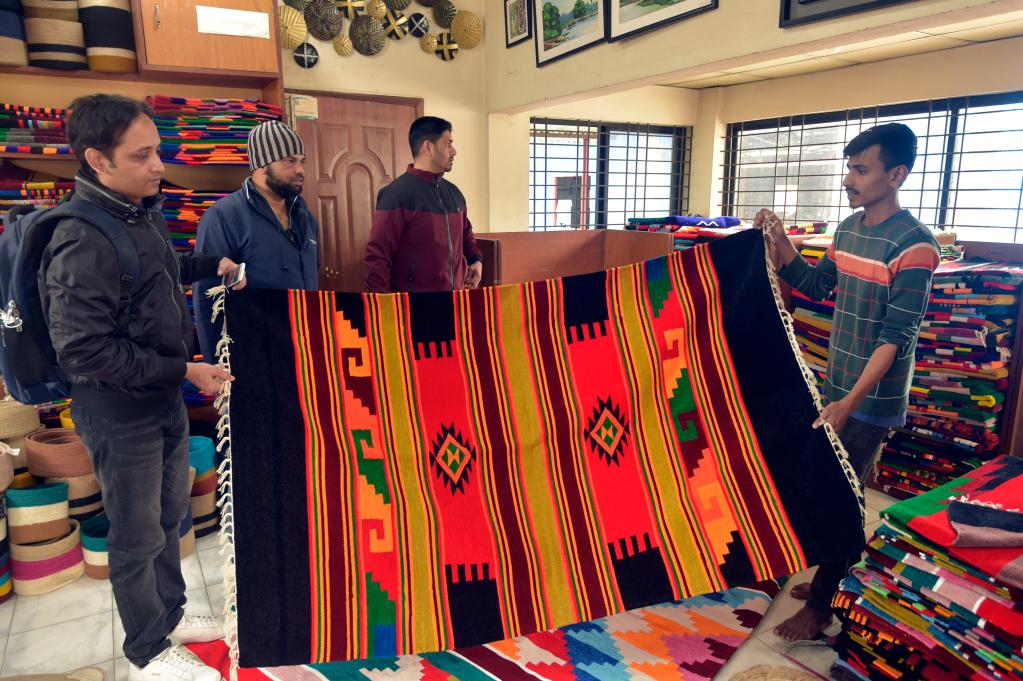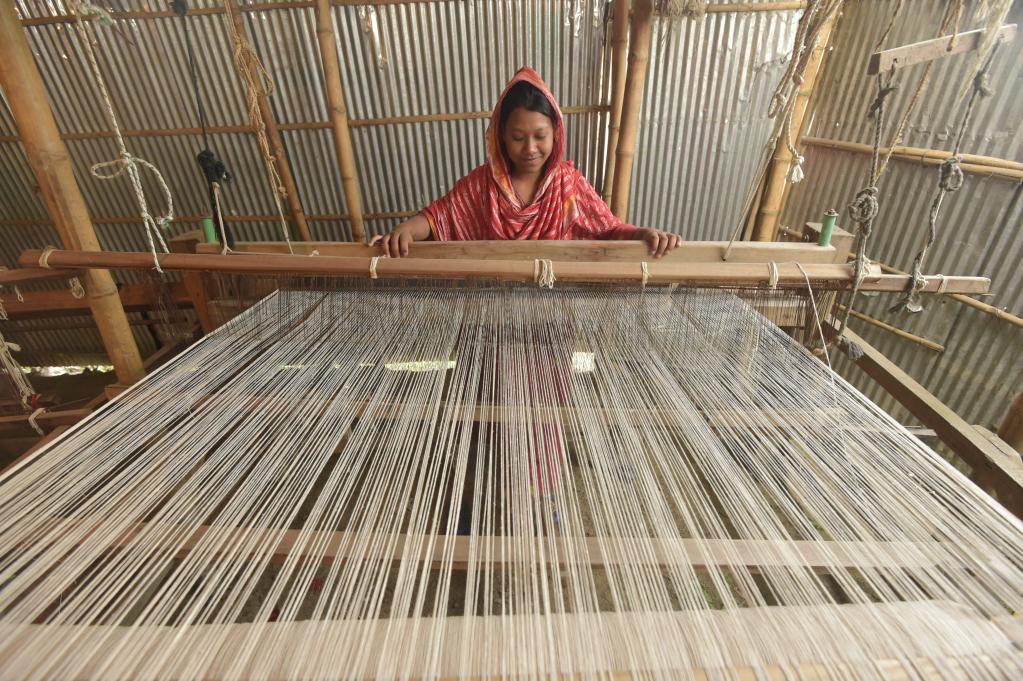Chinese raw materials ensure popularity of Bangladesh's traditional carpets

A salesperson shows shatranji to customers at a store in Rangpur, Bangladesh, Feb. 10, 2023. (Xinhua/Salim)
Shatranji, a carpet-like decor artifact considered as a symbol of aristocracy, is one of Bangladeshi's most popular exported handicraft products.
DHAKA, Feb. 28 (Xinhua) -- The northern Rangpur region of Bangladesh is known for traditional handcrafted Shatranji, a popular carpet-like decor artifact, the unique weaving techniques of which have been passed on from generation to generation.
The decorative artifact has recently been declared as a Geographical Indication Product of Bangladesh. Currently, the artistic pieces, considered as a symbol of aristocracy, are one of Bangladeshi's most popular exported handicraft products.
Md Manjurul Haque owns a Shatranji factory with 20 workers and their products have been sold in different parts of Bangladesh.
He told Xinhua recently that his father-in-law has been involved in the making of Shatranji in the Rangpur region since 1972.

A salesperson shows shatranji to customers at a store in Rangpur, Bangladesh, Feb. 10, 2023. (Xinhua/Salim)
"I later started this Shatranji factory in 2015 with the support of my father-in-law," Haque said.
"The popularity of the artifacts ensures my factory continues production and my workers keep earning," said Haque.
After all expenses are factored in, including workers' wages and import costs of raw materials, his net profit is healthy and business is good, said Haque.
The raw materials for Haque's business come from China.
"We bring raw materials from China and use them as per the design to make our artifacts. The quality of the raw materials ensures the Shatranji's popularity," he said.
Haque said Chinese raw materials are unmatched for making first-class Shatranji products.
"Our Shatranji products have gained a positive reputation abroad. We could do better, however, if we were provided with government support," he mentioned.

Photo shows shatranji products at a store in Rangpur, Bangladesh, Feb. 10, 2023. (Xinhua/Salim)
Saiful Islam is a non-resident Bangladeshi. He is currently living in Japan.
"I've come to visit the Rangpur Shatranji village," said Islam, adding that the Shatranji of Rangpur is a great heritage of Bangladesh.
"My friends in Japan or those who are close to me elsewhere in the world are particularly interested to know about these Shatranji products. So I'm here today to see and purchase them."
"The Shatranji is our tradition, the tradition of Bangladesh and the Rangpur tradition, and I will introduce this tradition to everyone including my friends, said Islam, who plans to take the Shatranji products back to Japan as souvenirs.
Meghla Rani is a female Shatranji worker from Ponkhy Phanda village under Rangpur district's Hazir Hat. She has been making Shatranji for almost 10 years.
"We're receiving many opportunities and benefits from this work," she said. "So, we're content working here."
"Before making Shatranji, I was so poor. My husband works in a different industry and I work here. Our family life has progressed and we can repay our loans," Rani said, adding that they can afford their children's education.

A woman works on a traditional wooden weaving machine to make shatranji at a workshop in Rangpur, Bangladesh, Feb. 10, 2023. (Xinhua/Salim)
Another worker Polly Rani also changed her fate by making traditional handicraft items.
She has been working at a Shatranji factory for about 10 years.
"When we get an order, we design by hand and sometimes we design by looking at the catalog," said Rani.
The quality of the finished artifact is down to the unmatched quality of the Chinese raw materials, according to her.

